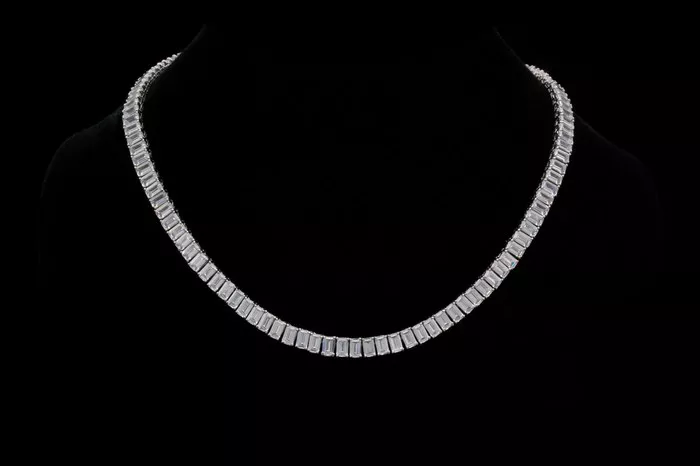A diamond necklace is often considered a timeless piece of jewelry, symbolizing elegance, luxury, and status. However, beyond its aesthetic and sentimental value, many people wonder if a diamond necklace has significant resale value. This article delves into the factors influencing the resale value of diamond necklaces, how to maximize their worth, and what potential sellers should be aware of.
Factors Affecting the Resale Value of Diamond Necklaces
Several key factors determine the resale value of a diamond necklace. Understanding these can help sellers set realistic expectations and take steps to enhance the value of their jewelry.
1. Diamond Quality: The 4 Cs
The quality of the diamonds in the necklace is paramount. The 4 Cs—carat, cut, color, and clarity—are the universally accepted standards for evaluating diamond quality.
Carat: This measures the weight of the diamond. Larger diamonds are rarer and generally more valuable.
Cut: The cut affects the diamond’s brilliance and sparkle. Well-cut diamonds are more appealing and valuable.
Color: Diamonds are graded on a scale from D (colorless) to Z (light yellow or brown). Colorless diamonds are more desirable and valuable.
Clarity: This refers to the presence of internal or external flaws. Diamonds with fewer inclusions and blemishes are more valuable.
2. Setting and Design
The design and craftsmanship of the necklace also play a crucial role. High-quality settings made of precious metals like platinum or gold can add significant value. Unique and intricate designs by renowned jewelers or designers can further enhance the necklace’s appeal and resale price.
3. Brand and Certification
Jewelry from reputable brands often commands higher resale prices. Certificates from recognized gemological laboratories, such as the Gemological Institute of America (GIA), can provide assurance about the diamond’s quality and authenticity, positively impacting its resale value.
4. Condition
The condition of the necklace is another critical factor. Well-maintained pieces without damage, such as chipped diamonds or broken clasps, are more likely to fetch higher prices. Regular cleaning and professional maintenance can help preserve the necklace’s condition and value.
5. Market Demand
The current market demand for diamond jewelry also affects resale value. Economic conditions, fashion trends, and consumer preferences can influence how much buyers are willing to pay for a diamond necklace at any given time.
Maximizing the Resale Value
If you’re considering selling a diamond necklace, several strategies can help maximize its resale value.
1. Professional Appraisal
Obtaining a professional appraisal from a certified gemologist or jeweler can provide an accurate estimate of the necklace’s value. An appraisal report can also be a useful tool when negotiating with potential buyers.
2. Proper Documentation
Ensure you have all relevant documentation, including the original purchase receipt, diamond certification, and any previous appraisals. Proper documentation can help establish the necklace’s provenance and authenticity, making it more attractive to buyers.
3. Maintenance and Cleaning
Keep the necklace in excellent condition by regularly cleaning it and having it professionally inspected. Address any repairs or maintenance needs promptly to avoid further damage and preserve its value.
4. Choose the Right Selling Platform
Consider various selling options, such as auctions, consignment with a reputable jeweler, or online marketplaces. Each platform has its advantages and potential drawbacks, so research thoroughly to choose the best option for your situation.
5. Market Timing
Selling during times of high demand, such as holiday seasons or when diamond prices are strong, can help you achieve a better resale price. Staying informed about market trends and conditions can guide your timing decisions.
Realistic Expectations
While diamond necklaces can retain significant value, it’s important to have realistic expectations. Typically, diamond jewelry resells for a fraction of its original purchase price. Understanding the reasons behind this can help manage expectations.
See Also: Can I Wear Garnet on the Left Hand?
1. Retail Markup
Retail prices often include substantial markups to cover overhead costs, branding, and profits. As a result, resale prices are usually lower than retail prices, reflecting the intrinsic value of the materials rather than the added retail markup.
2. Depreciation
Like many luxury items, diamond necklaces can depreciate over time, especially if they are not rare or unique. However, high-quality pieces with excellent craftsmanship and reputable branding may depreciate less or even appreciate in value over time.
3. Buyer’s Market
The resale market for diamond jewelry is often a buyer’s market, meaning buyers have numerous options and can negotiate lower prices. This can result in lower offers than sellers might expect based on the original purchase price.
Alternatives to Selling
If the resale value does not meet your expectations, consider alternative options that can still provide value from your diamond necklace.
1. Trade-In
Many jewelers offer trade-in programs where you can exchange your old jewelry for new pieces. This can be a practical way to upgrade your jewelry collection while retaining some value from your original piece.
2. Repurposing
Repurposing the diamonds into a new piece of jewelry can give them a new life and potentially add sentimental value. This option allows you to retain the diamonds’ intrinsic value while enjoying a fresh design.
3. Gifting
Passing down a diamond necklace as a family heirloom can provide significant emotional and sentimental value. It can become a cherished keepsake for future generations.
4. Insurance Coverage
If the resale value is low, maintaining insurance coverage on the necklace can provide financial protection against loss, theft, or damage, preserving some of its value indirectly.
Conclusion
A diamond necklace does have resale value, but the amount depends on various factors such as the quality of the diamonds, the design and craftsmanship of the necklace, the brand, and current market conditions. By understanding these factors and taking steps to maintain and document the necklace, sellers can maximize its resale value. However, it’s essential to have realistic expectations and consider alternative options if the resale value does not meet your needs. Whether selling, trading, or repurposing, a diamond necklace can continue to provide value in various ways.

